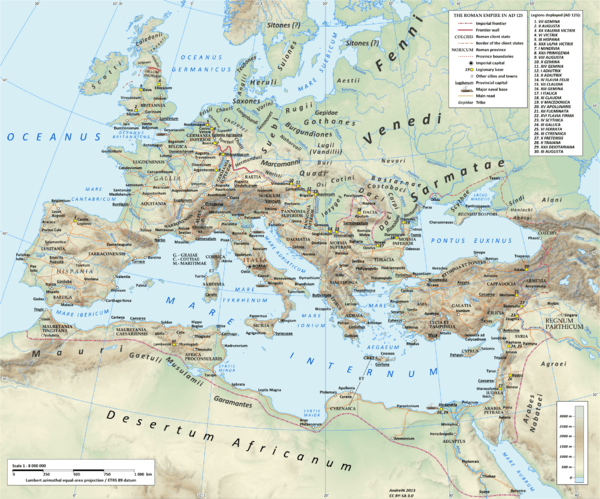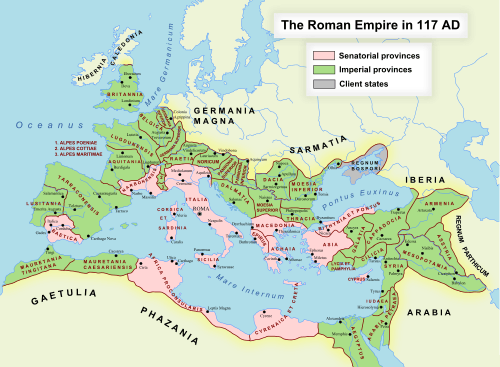Mauretania Caesariensis
| Provincia Mauretania Caesariensis | |||||
| Province of the Roman Empire | |||||
| |||||
 | |||||
| Capital | Caesarea | ||||
| Historical era | Classical Antiquity | ||||
| - | Established | 42 | |||
| - | Muslim conquest | 7th Century | |||
| Today part of | | ||||
Mauretania Caesariensis was a Roman province located in northwestern Africa, in present Algeria, with its capital at Caesarea (hence the name Caesariensis; one of many cities simply named after the imperial cognomen that had become a title), now Cherchell.
Historical background

In the first century AD, Roman Emperor Claudius divided the westernmost Roman province in Africa, named Mauretania (land of the people of the Mauri, hence the word Moors), into Mauretania Caesariensis and Mauretania Tingitana.
At the time of Diocletian and Constantine the Great, both provinces were assigned to the administrative Diocese of Africa, in the praetorian prefecture of Italy, while Tingitana was an outpost of the Diocese of Spain. Caesarea was a major center of Jewry before 330, Sitifis one of the centres of the soldier cult of Mithras. Christianity was spread throughout in the 4th and 5th century.
Under Diocletian's Tetrarchy reform, the easternmost part was broken off as a tiny separate province, Sitifensis, called after its inland capital Sitifis (Sétif) with a significant port at Saldae (presently Béjaïa).
Religion
Among the ruling class, Trinitarian Christianity was replaced by Arianism under the Germanic kingdom of the Vandals, which was established in 430, when the Vandals crossed the Strait of Gibraltar. The Vandal kingdom was extinguished by the Byzantine armies circa 533, but most of Mauretania Caesariensis remained under the control of local Moorish rulers such as Mastigas, and it was not until the 560s and 570s that Byzantine control was established in the interior. The Byzantine Exarchate of Africa was in its turn overrun by the Muslim caliphate under the Umayyad dynasty, ending Late Antique Roman culture there; most of former Mauretania Caesariensis became part of the westernmost Islamic province, henceforth called (al-)Maghrib.
Episcopal sees
Ancient episcopal sees of Mauretania Caesariensis listed in the Annuario Pontificio as titular sees:[1]
- Ala Miliaria
- Albulae
- Altava (Ouled Mimoun, Hadjar-Er-Roum)
- Amaura
- Ambia (near Hammam-Bou-Hanifia)
- Aquae in Mauretania
- Aquae Sirenses (ruins at Hammam-Bou-Hanifia)
- Arena (Bou-Saada?)
- Arsennaria (Bou-Râs?)
- Auzia (Aumale, Sour-Khazlam)
- Bacanaria
- Baliana (L'Hillil?)
- Bapara (near the promontory of Ksila?)
- Benepota
- Bida (ruins of Djemâa-Sahridj?)
- Caesarea in Mauretania
- Caltadria
- Capra
- Caput Cilla (ruins of El-Gouéa?)
- Cartennae
- Castellum Ripae (ruins of Hadjar-Ouaghef?)
- Castellum Tatroportus
- Castellum Tingitii
- Castellum Iabar
- Castellum Medianum
- Castellum Minus (Coléa, near Algiers)
- Castra Nova
- Castra Severiana (Lalla Marnia? Chanzy, Sidi-Ali-Ben-Joub?)
- Catabum Castra (Saint-Aimé, Djidioua?)
- Catrum
- Catula (Oued Damous?)
- Cenae (Kenais Islands)
- Cissi
- Columnata
- Corniculana
- Elephantaria in Mauretania (ruins at Harrach)
- Fallaba (Djelfa?)
- Fidoloma
- Flenucleta
- Floriana (Letourneux, Derrag?)
- Flumenzer (Bou Medfa)
- Fronta
- Giru Mons (ruins of Yerroum?)
- Gratianopolis
- Gunugus (Sidi-Brahim)
- Gypsaria (Honeïn)
- Ida in Mauretania
- Igilgilli (in the valley of Bou-Sellam?)
- Iomnium (Tzigiri)
- Ita
- Iunca in Mauretania
- Lamdia
- Lari Castellum (Imilaën)
- Maiuca
- Malliana
- Manaccenser (in the region of Cherchell)
- Masuccaba
- Maturba
- Maura (Douelt-Zerga?)
- Mauriana
- Maxita (in the region of Al-Asnam?)
- Media
- Mina (ruins near Rezilane)
- Muteci (near Aïn-El-Anab?)
- Nabala
- Nasbinca
- Noba
- Novica (ruins of Aïn-Nouïssy?)
- Numida (in the territory of Amoura)
- Obbi
- Obori
- Oppidum Novum
- Panatoria
- Pomaria
- Rapidum (Masqueray, Sour-Djouab)
- Regiae (Arbal)
- Reperi
- Rusada
- Rusguniae
- Rusubbicari
- Rusubisir (in the territory of Tiza)
- Rusuccuru
- Satafi
- Sereddeli
- Serta
- Sesta
- Sfasferia
- Siccesi (ruins of Takembrit)
- Sinnada in Mauretania (ruins of Kenada?)
- Sita (in the west of the province
- Subbar
- Sufar
- Sufasar
- Summula
- Tabaicara
- Tabla (Tablat?, Tablast?)
- Taborenta (ruins near Saida?)
- Tabunia
- Tamada (Aïn-Tamda near Masqueray?)
- Tamazuca (ruins of Grimidi?)
- Tanaramusa (Mousaïaville, El-Hadjeab? Berrouaghia?)
- Tasaccora (Sigi)
- Tatilti
- Tigamibena
- Tigava
- Tigisi in Mauretania (between Dellys and Taourga)
- Timici (Timsionin?)
- Timidana
- Tingaria (Tiaret?)
- Tipasa in Mauretania
- Tubia (ruins of Henchir-Toubia?)
- Tubunae in Mauretania
- Turris in Mauretania
- Tuscamia
- Ubaba
- Usinaza (Seneg)
- Vagal (near the ruins of Sidi-Ben-Thiour)
- Vanariona (ruins of Ksar-Tyr?)
- Vannida
- Vardimissa (near Medjana)
- Villa Nova
- Vissalsa (on the Oued-Melah river?)
- Voncaria (ruins of Boghar?)
- Voncariana (near the ruins of Boghasi?)
- Vulturia (ruins at the Falco promontory?)
- Zucchabar
Economy
The principal exports from Caesariensis were purple dyes and valuable woods; and the Amazigh or Mauri were highly regarded by the Romans as soldiers, especially light cavalry. They produced one of Trajan's best generals, Lusius Quietus, and the emperor Macrinus.
See also
- Notitia Dignitatum
- Pauly-Wissowa
References
- ↑ Annuario Pontificio 2013 (Libreria Editrice Vaticana, 2013, ISBN 978-88-209-9070-1), "Sedi titolari", pp. 819-1013
Sources
- Westermann, Großer Atlas zur Weltgschichte (in German)
| ||||||||
| ||||||||||||||||||||||||||||||||||||||||||||||||||||||||||||||||||||||||||
